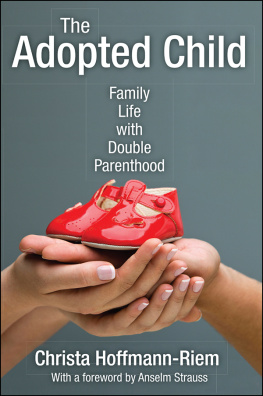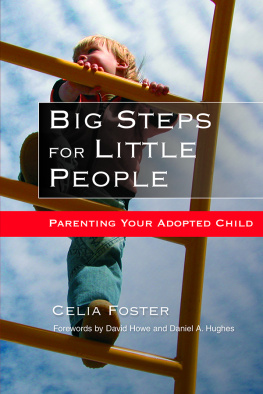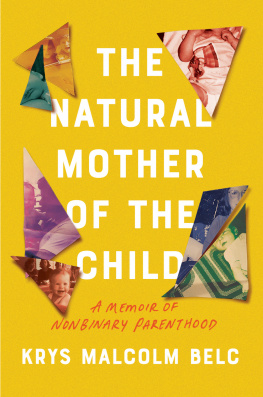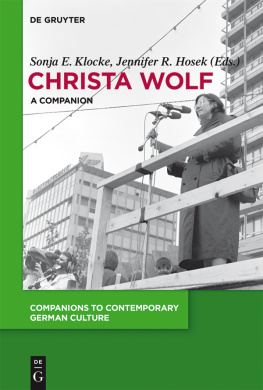First published 1990 by Transaction Publishers
Published 2017 by Routledge
2 Park Square, Milton Park, Abingdon, Oxon OX14 4RN
711 Third Avenue, New York, NY 10017, USA
Routledge is an imprint of the Taylor & Francis Group, an informa business
Copyright 1990 Taylor & Francis.
All rights reserved. No part of this book may be reprinted or reproduced or utilised in any form or by any electronic, mechanical, or other means, now known or hereafter invented, including photocopying and recording, or in any information storage or retrieval system, without permission in writing from the publishers.
Notice:
Product or corporate names may be trademarks or registered trademarks, and are used only for identification and explanation without intent to infringe.
Library of Congress Catalog Number: 89-4609
Library of Congress Cataloging-in-Publication Data
Hoffmann-Riem, Christa.
[Adoptierte Kind. English]
The adopted child: family life with double parenthood / Christa Hoffmann-Riem; translated from German by Mike Brookman.
p. cm.
Translation of: Das adoptierte Kind.
Bibliography: p.
Includes index.
ISBN 0-88738-241-X
1. AdoptionGermany (West) 2. Children, AdoptedGermany (West)
I. Title.
HV875.58.G3H6413 1989
362.7340943dc20
89-4609
CIP
ISBN 13: 978-1-4128-6296-7 (pbk)
To Wolfgang, Holger, and Martin
Aside from the general excellence of this book, I enthusiastically recommend it to you. There is something in it for several rather different audiences. Its title should immediately alert those readers (both professional and lay) who are concerned with adoption. They will certainly learn something here about the experiences of adopting parents and adopted children. The action is laid in Germany, for the author is a professor of sociology at the University of Hamburg, and her study is about Germans. Her research, as reported here, has been sufficiently important in Germanyand its import is of such general interest that the editors of Transaction Books have correctly believed an English translation warranted. (The translation is excellent.) I commend them for this, especially because it takes great effort and sometimes considerable diplomacy for social science books to cross to this side of the ocean.
Aside from its specific information about adoption, Christa HoffmannRiems research is both informative and stimulating with regard to some very subtle aspects of the normal nuclear family. There are wonderfully rich data bearing both on adoptive and nonadoptive families in the form of case studies and lengthy quotations taken from the interviews. Because these materials were gathered by a type of interview pioneered in Germany and still relatively unknown in the United States, social scientists interested in qualitative methods of research are likely now for the first time to read about, and later cite, this approach to data as used in Hoffmann-Riems book.
Not just method and data but also theory is a strong point of her presentation: theory bearing on adoption of course, but also on more general sociological issues such as normality, identity, stigma, secrecy and disclosure, and the relationships between public and private life. (Her own theoretical perspective is a combination of symbolic interactionism, phenomenology, and ethnomethodology, but she makes wide and catholic use of concepts from other traditions.) Of course, anyone interested in Germans and German society will find her materials revealing and her interpretations of them insightful and wise. What I am suggesting is that American readers might also find quite fascinating both the similarities and differences between our respective countries with regard to family life, adoption, child rearing, and identity.
Now, in the brief space of this foreword I will add a few specific points. One of the books central topics, carefully discussed and analyzed, concerns the matter of secrecy and disclosureor in technical vocabulary, closed and open awarenesswith regard to the childrens biological or adoptive origins. Whether a child knows it has been adopted, and at what age it learns or is told, proves to be (just as some adoptive experts have asserted) immensely important; but this is also true for the parents. These consequences are linked with how much the child and its adoptive parents actually know or are told, and in what detail and with what accuracy, about the birth parents.
The author uses a number of sociological concepts, either coined or adopted from the sociological literature, when interpreting these and other phenomena. Two central ones of her own coinage are as-if normalization and own-type normalization. (I leave readers who are curious about these to discover their meanings for themselves.) A more transparently meaningful concept is that of double parenthood. Because I am especially interested in the varied aspects of work, I paid much attention to Hoffmann-Riems discussion of several types of what I call biographical work that I hadnt thought of, or now am stimulated to think more about. Among these are reconstructive work, accounting work, and integrative work.
The studys central method lor data gathering and achieving deep analysis is a combination of the narrative interview. invented and effectively used by Professor Fritz Schuetze (University of Kassel), and a biographical analysis, also worked out in detail by him. The interviewee is asked to tell his or her life story (in this instance, the story of the adoptive experiences), and is asked to talk until the entire narrative is told. Then questions are asked by the interviewer about points that seem conflicting, ambiguous, puzzling, and so on, as well as when a point is judged to need more elaboration. In this particular book, portions of the adoptive stories are reproduced in large numbers as data. These function as they always doto promote our understanding, give us a sense of being there, and enhance the credibility of the authors interpretationsbut they also provide marvelous windows on the experience of the adoptive parents and their adopted children. The American literature on adoption has many such stories, some presented at much greater length, but certainly few books can have offered commentary on them of such analytic depth or clarity.
Out of the vast literature on adoption Professor Hoffmann-Riem herself especially refers to David Kirk, to whose writings she is greatly indebted. However, as she remarks early, a lot of other studies on adoption proved to be less helpful for her analysis than theoretical studies from quite other fields. She may have underestimated the theoretical quality of the adoption literature (I doubt it), and she surely was not being denigrating in saying so; but it is a measure of the uniqueness and value of her research that she could say this. What was said about her book by another German colleague, to me, was equally instructive. Reading it taught him how basically conservative his countrymen really are, despite the apparently great changes in German society. You need not agree with his conclusion to understand why some German readers may have found the book fascinating, even if reacting subliminally to this aspect of German society. In closing, and returning again to the books primary subject matter: Reading about adoption we find very good and grounded reasons for an explicit but stylistically subdued reform thrust of Professor Hoffmann-Riems presentation concerning the matter of early and well-managed disclosure of adoptive identity to the child. But whether secretive or open toward this highly charged issue, adoptive families certainly do shed considerable light, just as the author claims, on the nature of the nonadoptive or so-called normal family.











